WASP-96 is a yellow dwarf located about 1,160 light-years away in the constellation Phoenix. Shining at magnitude 12.2, it is invisible to the unaided eye. The Sun-like star hosts at least one exoplanet, WASP-96b, discovered in 2013. In 2022, the planet was one of the first targets of NASA’s James Webb Space Telescope (JWST).
Star type
WASP-96 is a yellow main sequence star of the spectral type G8. It has a mass of 1.06 solar masses and a radius of 1.05 solar radii. With a surface temperature of about 5,540 K, the star is slightly cooler than the Sun (5,772 K). Even though it has similar properties to the Sun, WASP-96b is more than twice as old. It has an estimated age of 9.40 billion years.
WASP-96 hosts an exoplanet, WASP-96b, which orbits the parent star at just one-ninth of the distance between the Sun and Mercury. The hot Saturn exoplanet is roughly the size of Jupiter with half the mass. It does not have a direct analog in the solar system. The planet’s spectrum was imaged by the James Webb telescope in 2022. The data obtained by the JWST has given astronomers a unique opportunity to analyze the planet’s atmosphere and revealed that it contains water.
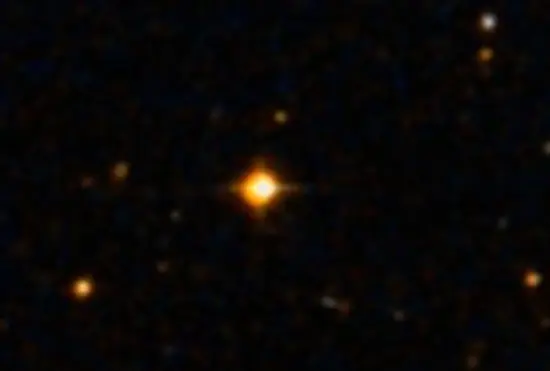
WASP-96, image: Wikisky
Habitable zone
The habitable zone of WASP-96 lies at a distance between 0.698 astronomical units and 1.470 astronomical units from the host star. The inner boundary (0.698 AU) corresponds to the orbital distance at Venus’ equivalent radiation, while the outer boundary (1.470 AU) corresponds to that of Mars’ equivalent radiation. The orbital distance at Earth’s equivalent radiation is 0.965 astronomical units.
The planet WASP-96b does not orbit within the habitable zone. It is too close to the star and too hot for liquid water to exist on its surface.
WASP-96b
WASP-96b is a gas giant planet discovered orbiting WASP-96 in 2013. It is one of more than 5,000 known extrasolar planets in the Milky Way. The exoplanet has a mass of 0.48 Jupiter masses and a radius of about 1.20 Jupiter radii. It orbits the parent star, WASP-96, at a distance of only 0.0453 astronomical units, taking 3.425 days to complete an orbit. The planet’s temperature is about 1,285 K.
WASP-96b was detected in 2013 by the Wide Angle Search for Planets (WASP), an international consortium that uses an array of robotic telescopes to perform transit photometry and discover exoplanets. The planet was discovered by a team of researchers at Keele University led by Professor Coel Hellier. The discovery was announced in 2014.
Observations with the James Webb Space Telescope in 2022 revealed a distinct signature of water. This was not the first time water was detected on an exoplanet. The Hubble Space Telescope (HST) has analyzed the atmospheres of many extrasolar planets over the past 20 years and detected the presence of water on five planets for the first time in 2013. The planets in question were WASP-17b, HD 209458b, WASP-12b, WASP-19b, and XO-1b.
Prior to the JWST observations, WASP-96b was believed to have a cloud-free atmosphere, but data obtained with the telescope indicates evidence of clouds and haze in the exoplanet’s spectrum.
Astronomers have long believed that hot gas giants were rich in sodium but could not confirm this because sodium has a signature too weak to be detected. However, an international team of astronomers led by Dr. Nikolay Nikolov of the University of Exeter found evidence of sodium using the European Southern Observatory’s (ESO) Very Large Telescope in 2018.
This led them to believe that there were no clouds in WASP-96b’s atmosphere because sodium could not be detected if clouds cloaked its signature. As part of the research, astronomers at the University of Exeter, Dublin City University, and University of California, Santa Cruz, studied more than 20 exoplanet transit spectra and WASP-96 was the only exoplanet that showed a clear sodium signature.
The amount of sodium detected in WASP-96b is comparable to the amounts on Earth and other planets in the solar system, indicating that conditions may be similar as well. The research was published in the journal Nature in 2018.
The presence of a clear atmosphere was confirmed in a study published in July 2022. The researchers used the Inamori-Magellan Areal Camera and Spectrograph (IMACS) at Las Campanas Observatory in Chile to obtain a transmission spectrum at 475-825 nm and detected a broad sodium absorption feature. However, the JWST data, released only days later, showed that the atmosphere of the planet was not cloud-free.
James Webb Telescope image
Astronomers used Webb’s Near-Infrared Imager and Slitless Spectrograph (NIRISS) to capture the planet’s transmission spectrum. They detected not only water but evidence of clouds and haze. The Webb observations made it possible for researchers to analyze an extrasolar planet’s atmosphere at a distance of more than 1,000 light-years in unprecedented detail.
The James Webb telescope did not capture a direct image of WASP-96b or the atmosphere of the planet. The image behind the transmission spectrum is an illustration based on the available data collected with NIRISS spectroscopy and during previous observations.
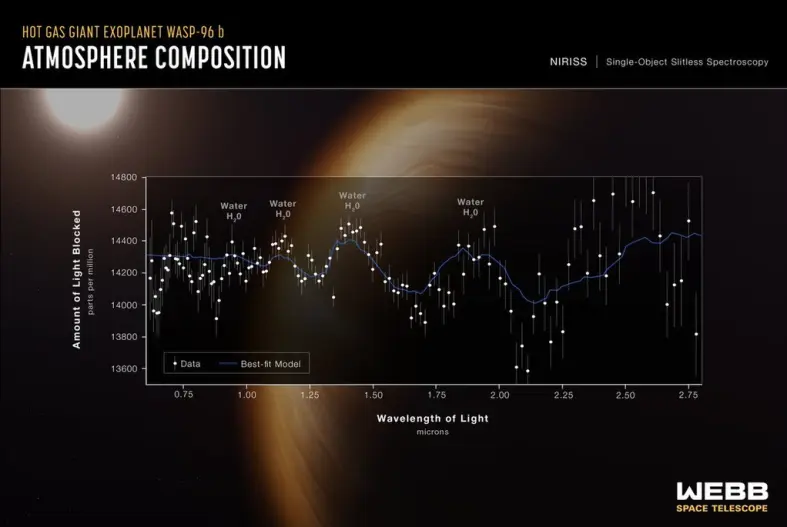
WASP-96b – Researchers are able to detect and measure the abundances of key gases in a planet’s atmosphere based on the absorption pattern – the locations and heights of peaks on the graph: each gas has a characteristic set of wavelengths that it absorbs. The temperature of the atmosphere can be calculated based in part on the height of the peaks: a hotter planet has taller peaks. Other characteristics, like the presence of haze and clouds, can be inferred based on the overall shape of different portions of the spectrum. Credit: NASA, ESA, CSA, STScI
The spectrograph captured the most detailed transmission spectrum of an extrasolar planet’s atmosphere to date. It measured light from WASP-96 for 6.4 hours as the planet transited across the parent star on June 21, 2022. Webb observed the star system before, during, and after the transit. The transit itself lasted for just under 2.5 hours. The amount of light blocked during the transit ranged from 1.36% to 1.47%.
Astronomers obtained a light curve that showed the change in the star’s brightness during the transit, as well as a transmission spectrum showing the brightness change of specific infrared wavelengths between 0.6 and 2.8 microns. Wavelengths longer than 1.6 microns make it possible to detect water, as well as molecules of oxygen, carbon dioxide, and methane.
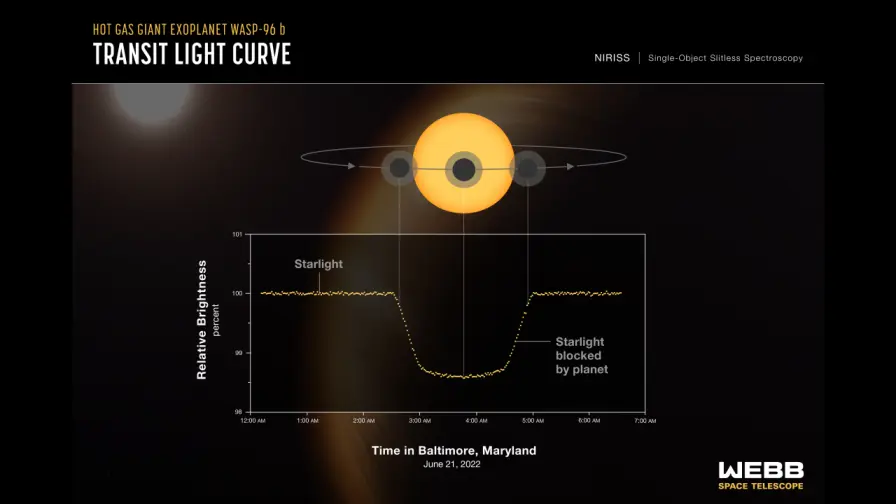
WASP-96b transit light curve – A transmission spectrum is made by comparing starlight filtered through a planet’s atmosphere as it moves across the star, to the unfiltered starlight detected when the planet is beside the star. Each of the 141 data points (white circles) on this graph represents the amount of a specific wavelength of light that is blocked by the planet and absorbed by its atmosphere. Credit: NASA, ESA, CSA, STScI
The light curve confirmed the planet’s previously determined properties – orbit and size – while the transmission spectrum showed the signature of water, the presence of clouds, and signs of haze.
The spectrum of WASP-96b will allow astronomers to determine the amount of water vapour and the abundances of elements like oxygen and carbon in the planet’s atmosphere. The information can then be used to make inferences about the conditions and history of the planet.
Facts
The transmission spectrum of WASP-96b was included among the first images captured by the James Webb Space Telescope (JWST). Other early targets included the Carina Nebula in Carina, Stephan’s Quintet of galaxies in Pegasus, the Southern Ring Nebula (NGC 3132) in Vela, and a deep field view of SMACS 0723, a galaxy cluster that acts as a gravitational lens for distant galaxies, located in the constellation Volans. The five images were released on July 12, 2022.
Name
WASP-96 does not have a formal name. The designation WASP-96 is an abbreviation for Wide Angle Search for Planets (WASP), an exoplanet detection program operated by the Isaac Newton Group of Telescopes (ING), Instituto de Astrofísica de Canarias (IAC), and six universities in the United Kingdom. The planets detected by WASP were assigned numbers in the order of discovery.
Location
WASP-96 lies in the southern constellation Phoenix, near the triangle formed by Ankaa (Alpha Phoenicis) with Epsilon and Kappa Phoenicis. The yellow dwarf is found roughly halfway between the bright Achernar in Eridanus and Fomalhaut in Piscis Austrinus.
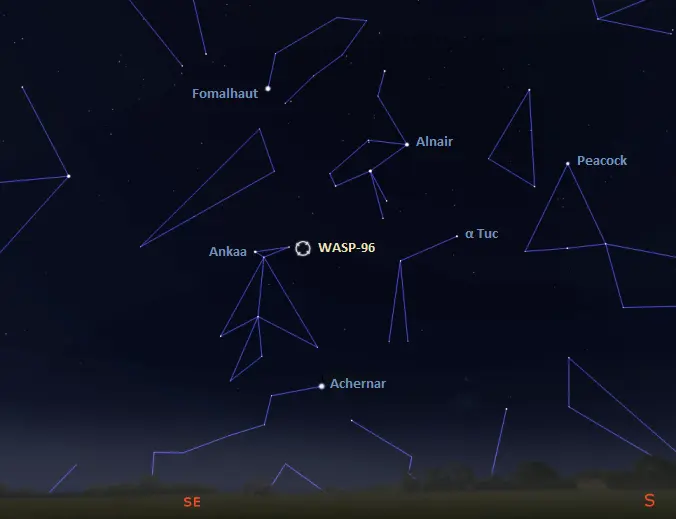
The location of WASP-96, image: Stellarium
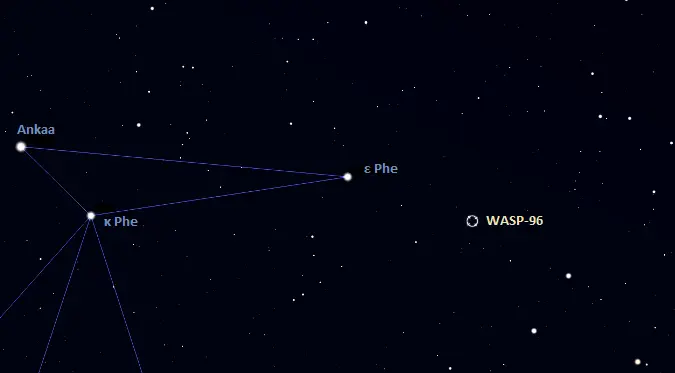
WASP-96 location, image: Stellarium
Constellation
WASP-96 lies in the constellation Phoenix. Phoenix occupies 469 square degrees of the southern sky near Achernar and is largely unknown to northern observers. It is one of the constellations created by the Dutch-Flemish astronomer Petrus Plancius in the 16th century. Plancius created these constellations based on the observations of Dutch navigators and celestial cartographers who had mapped the southern sky during their voyages to the southern hemisphere. Phoenix was first depicted on Plancius’ celestial globe in 1597 and later in Johann Bayer’s celestial atlas Uranometria (1603).
Phoenix is not particularly bright. The only star in the constellation brighter than magnitude 3.00 is Ankaa (Alpha Phoenicis), an evolved class K giant that shines at magnitude 2.377. The star’s name is an Arabic word for “phoenix.” Other notable stars in Phoenix include the binary star Beta Phoenicis, composed of two yellow giants, the variable red giants Gamma and Psi Phoenicis, the Algol variable Wurren (Zeta Phoenicis), the Population II star HE0107-5240, one of the oldest stars known (13 billion years old), and the short-period pulsating variable SX Phoenicis.
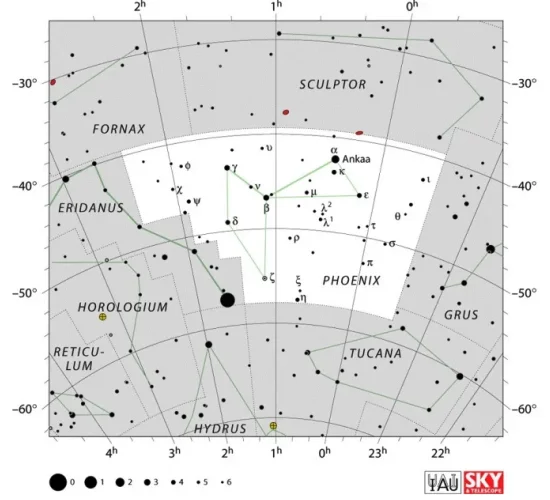
Phoenix constellation map by IAU and Sky&Telescope magazine
The constellation is home to several interesting deep sky objects. These include the interacting galaxy group known as Robert’s Quartet, the dwarf barred spiral galaxy NGC 625, the Phoenix Cluster, one of the most massive galaxy clusters known, El Gordo (ACT-CL J0102-4915), the largest distant galaxy cluster discovered (located more than 7 billion light-years away), and the edge-on galaxy ESO 243-49, home to Hyper-Luminous X-ray source 1 (HLX-1), an intermediate-mass black hole candidate, discovered in 2009.
The best time of year to observe the stars and deep sky objects in Phoenix is during the month of November. The entire constellation is visible from locations between the latitudes 32° N and 80° S.
The 10 brightest stars in Phoenix are Ankaa (Alpha Phe, mag. 2.377), Beta Phoenicis (mag. 3.30), Gamma Phoenicis (mag. 3.41), Epsilon Phoenicis (mag. 3.87), Kappa Phoenicis (mag. 3.94), Delta Phoenicis (mag. 3.93), Wurren (Zeta Phe, mag. 3.9 – 4.4), Eta Phoenicis (mag. 4.36), Psi Phoenicis (mag. 4.3 – 4.5), and Mu Phoenicis (mag. 4.59).
WASP-96
| Spectral class | G8 |
| Apparent magnitude | 12.2 |
| Absolute magnitude | 25.0 |
| Distance | 1,160 ± 20 light-years (356 ± 5 parsecs) |
| Parallax | 2.8590 ± 0.0154 mas |
| Radial velocity | – 0.90 ± 1.01 km/s |
| Proper motion | RA: 25.594 ± 0.011 mas/yr |
| Dec.: 2.192 ± 0.015 mas/yr | |
| Mass | 1.06 ± 0.09 M☉ |
| Radius | 1.05 ± 0.05 R☉ |
| Temperature | 5,540 ± 140 K |
| Metallicity | 0.14 ± 0.19 dex |
| Age | 9.40 ± 2.90 billion years |
| Constellation | Phoenix |
| Right ascension | 00h 04m 11.1376764234s |
| Declination | −47° 21′ 38.320831738″ |
| Names and designations | WASP-96, TOI-247, TIC 160148385, 1SWASP J000411.14-472138.2, 2MASS 00041112–4721382, Gaia DR2 4990044668377961984, Gaia EDR3 4990044668377961984 |